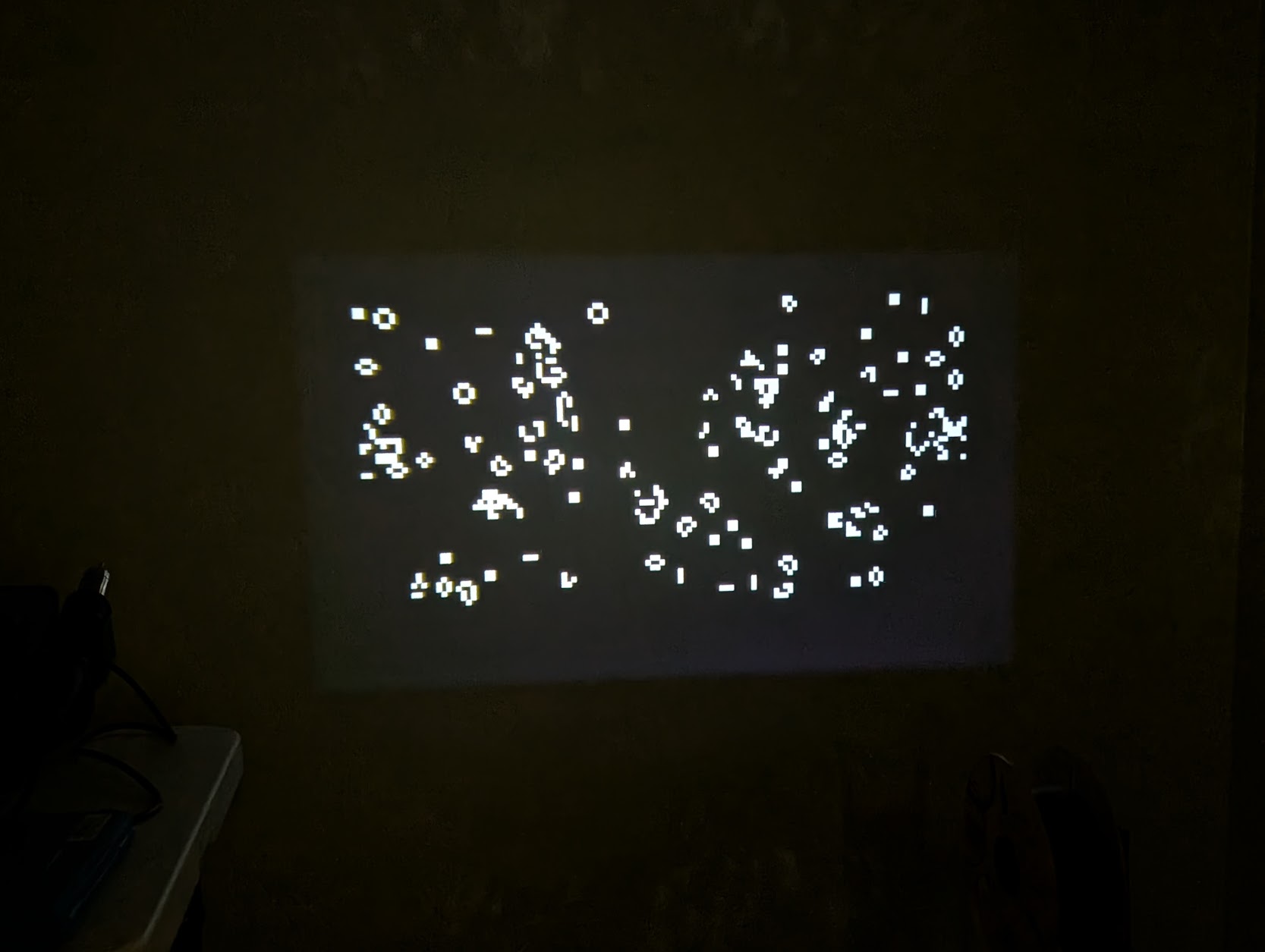Conway’s Game of Life
A classic “game” is Conway’s Game of Life (CGOL). It is not a game in the playable sense, but is an entertaining curiosity. CGOL is a type of cellular automata: complex behaviour arising from a simplistic set of rules. It has been widely studied, especially by mathematicians. Conway himself was a mathematician.

An example of rendered output from the CGOL game.
Requirements
The CGOL implementation for NuttX relies on a frame buffer driver, that is:
Framebuffer Character Driver. If you have
VIDEO_FB enabled, you should be able to use the app. The visuals for the
game are rendered to a display through the provided frame buffer.
Note
CGOL currently only supports devices with 32, 24, 16 or 8 bpp rendering. Since the game is only two colours, 1 bpp rendering can be supported as well, I just didn’t want to bother playing with individual bit operations any more by the time I got to the end of writing the application. By all means, please send patches!
The implementation was only tested on a 32bpp frame buffer device.
This game works for frame buffers that require FB_UPDATE as well. It does
nothing special with overlays.
Usage
The game can be played by simply running it in the NSH console:
nsh> cgol
The game will use the frame buffer device specified by
CONFIG_GAMES_CGOL_FBDEV to render the image. By default, that is
/dev/fb0. If you wish to use a different device at run-time, you can pass
the frame buffer device path as the first argument:
nsh> cgol /dev/fb1
Note that the game will loop forever and render the output to the screen. After
a certain point, CGOL reaches a “stable” configuration and there is not really
anything interesting to watch. At this point, you can terminate the application
with CTRL + C. You can also run the app in the background by adding the
& character after the command in NSH, which is recommended if you want to do
things in the console after running it.
Warning
This program has not been tested with bpp values other than 32. It may
have unknown bugs.
It has also not been tested with devices that have a word size
(sizeof(unsigned int)) other than 32 bits.
Configuration options
There are a few options you can customize in order to modify the game. The first two are very obvious: the map width and map height.
CONFIG_GAMES_CGOL_MAPWIDTHCONFIG_GAMES_CGOL_MAPHEIGHT
These options select the width and height of the game map in cells. You must
pick a width which is a multiple of sizeof(unsigned int) * 8. This is a
necessary evil in order to implement CGOL efficiently on embedded device. Often
times, this value is your device’s natural word size in bits. So, if you’re
using a 32 bit machine, pick a map width that is a multiple of 32. There is no
such restriction for the map height.
To change the amount of cells used to populate the map initially, you can modify
the density: CONFIG_GAMES_CGOL_DENSITY. The number of cells that are
generated at start is then TOTAL_CELLS * (1 / density), where total cells
is the map area.
The next thing you can change is the delay between frames in microseconds, using
the option: CONFIG_GAMES_CGOL_FRAMEDELAY. By default this value is 0 (no
delay). Use this if the rendering is too fast for you to appreciate each frame.
Purely for rendering reasons, the last option you can change is
CONFIG_GAMES_CGOL_DBLBUF. This enables double buffering for rendering, which
allocates a RAM buffer of equal size to the actual framebuffer. All rendering is
performed directly on the RAM buffer, and then copied to the framebuffer once
done. This is only necessary on some devices. For instance, the Raspberry
Pi 4b experiences
significant artifacts and completely incorrect rendering if double buffering is
not used.
Implementation
The game itself is implemented using bit-fields to represent living and dead
cells. A 1 bit is alive, and a 0 is dead. I used the natural word size
of the machine to store the bits, which is why I impose the restriction that the
map width must be a multiple of the number of bits in an unsigned int.
More bits in a word equates to more parallelism. When rendering living cells, I can skip over 32 cells at once on a 32-bit machine if the word evaluates to 0. This saves 32 iterations. The bit-fields themselves are also a space saver, as opposed to using 1 byte per cell, for instance. Even representing living cells as (x, y) pairs consumes more memory, and also takes significantly more CPU power to advance the game state at each step.
The main loop consists of the following steps:
Render living cells
Sleep if user configured frame delay
Display render
Advance the state of the game
Clear the render
The map is randomly initialized with living cells using rand(), which is a
uniform distribution. This isn’t always the best for CGOL; a certain density
needs to be achieved for interesting evolutions. I have settled on a density of
1/6 of the map.
The game is auto-scaled to fill as much of the frame buffer as possible. The minimum resolution is one pixel per cell. If the configuration has a map size larger than the frame buffer, the program will exit with an error.
Finally, the map wraps around from right to left. It does not wrap from top to bottom to allow a more memory efficient method of buffering the next state as it is calculated.
Todo
This program could be improved with:
1 bit support
Optional input device support for re-initializing the game, maybe drawing cells
Optional ability to load seeds
Runtime speed controls